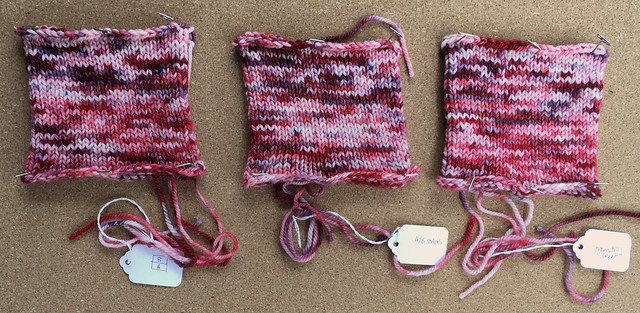A while back, I shared a free tutorial showing how to solar dye yarn with Kool-Aid - click here if you missed it! The resulting skeins were begging me to knit with them, and even though they were dyed at the same time, there are natural variations between the two which could become all too apparent when used in the same project.
In the name of science, all of these swatches were knit on the same needles (Knitter's Pride Nova Platina 9" fixed circulars) using the same number of stitches in the round (45, to be exact). Above left is a swatch knit entirely with Skein A; to the right, the swatch is knit entirely with Skein B.
Next, I knit the following three swatches:

Hand-dyed yarns, even those which come from the same dye lot, can really benefit from one simple trick to "blend" the yarns before your eyes: alternating skeins. It may sound fussy and annoying, but there's nothing sadder than the telltale line where you joined a new skein of yarn to your project. To me, it's worth juggling a few balls of yarn, but I know it can be a tough sell for some knitters. So, I decided to let the skeins and the swatches do the talking!
In the name of science, all of these swatches were knit on the same needles (Knitter's Pride Nova Platina 9" fixed circulars) using the same number of stitches in the round (45, to be exact). Above left is a swatch knit entirely with Skein A; to the right, the swatch is knit entirely with Skein B.
Next, I knit the following three swatches:

Above to the far left is the swatch which is knit using Skein A for the first half, then Skein B for the second half of the swatch, resulting in a visible line where the skeins were switched.
For the middle swatch pictured above, I knit two rounds with Skein A and two rounds with Skein B, repeating these 4 rounds for the entirety of the swatch, which really evens out the differences between the two skeins.
Lastly, for the swatch pictured above on the far right, I knit the first inch of the swatch with Skein A, then knit 2 rounds with Skein B, 2 rounds with Skein A, repeating these 4 rounds again before I switch over entirely to knitting the rest of the swatch with Skein B. Sometimes this "cheat" really works, and sometimes it doesn't; in this particular case, I think it's a close second to the middle swatch, but definitely preferable to the swatch on the far left. It can be a great last-minute fix to trot out when you realize your next skein looks just a touch different and you really don't want to rip all the way back to alternate skeins from the start - but in the example here, the two skeins are just a bit too different to really pull it off.
I have more examples of projects knit with hand-dyed yarns where I do/don't alternate skeins here on a previous blog post if you want to see some real-life examples. If you have had success (or heartache) with projects using multiple skeins of hand-dyed yarns, be sure to share them in the comments!
I have more examples of projects knit with hand-dyed yarns where I do/don't alternate skeins here on a previous blog post if you want to see some real-life examples. If you have had success (or heartache) with projects using multiple skeins of hand-dyed yarns, be sure to share them in the comments!

I'm thinking the one on the far left is the half-A and half-B? I agree, the middle swatch is the best. Thanks for the tip - I didn't know that is how you would merge two different skeins. I knit a lot of socks and haven't had the problem yet.
ReplyDelete